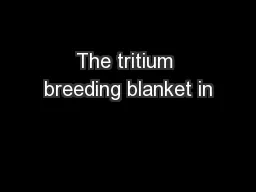

Tokamak fusion reactors T Onjun1 S Sangaroon2 J Prasongkit3 A Wisitsorasak4 R Picha5 J Promping5 1 Thammasat University Pathumthani Thailand ID: 564189
Download Presentation The PPT/PDF document "The tritium breeding blanket in" is the property of its rightful owner. Permission is granted to download and print the materials on this web site for personal, non-commercial use only, and to display it on your personal computer provided you do not modify the materials and that you retain all copyright notices contained in the materials. By downloading content from our website, you accept the terms of this agreement.
Slide1
The tritium breeding blanket in Tokamak fusion reactors
T.
Onjun1), S
.
Sangaroon2),
J.
Prasongkit3),
A
.
Wisitsorasak4), R
.
Picha5),
J.
Promping5)
1
)
Thammasat
University,
Pathumthani
, Thailand
2
)
Mahasarakham
University,
Mahasarakham
, Thailand
3
)
Nakhon
Phanom
University,
Nakhon
Phanom
, Thailand
4)
King Mongkut’s University of Technology
Thonburi, Thailand
5
)
Thailand Institute of Nuclear Technology, Bangkok, Thailand
Slide2
Kingdom of ThailandThailand is a country on Southeast Asia’s Indochina peninsulaPrevious called “Siam”
Member of “ASEAN”
Capital
: BangkokPopulation: 65.12 million (2015)Currency: Thai bahtSlide3
Thailand: Land of Smiles
Rich of Nature and CultureSlide4
The
fuels
for fusion reactions
are in the plasma state. Thus, they are
confined by magnetic field of
the tokamak.
Alpha particles are trapped inside while
neutrons
can
escape from the
core of
the
tokamak. Neutrons can be used to heat up water to produce electricity, similar to a fission power plant.
Fusion reactions for future energySlide5
International Thermonuclear Experimental Reactor (ITER)
ITER parameter
Achieved
Total fusion
power
500 MW
Major radius,
a
6.2 m
Minor radius,
R
2.0 m
Additional heating
73 MW
Electron density,
n
e
1
10
20
m
-3Pulse length > 400 sPlasma volume837 m3
to demonstrate the scientific and technical feasibility of fusion power
One key success of ITER is an R&D on first wall material and blanketSlide6
Understanding plasma in tokamakTransport code is used to simulate plasma evolution
To be published in NF 2016Slide7
Fusion ReactorsSlide8
Surface Material is a Key Item for Fusion Development
Challenges for fusion materials technology
Very high heat loads for materials facing the plasma
Damage to the structure caused by high-energy neutrons
Hydrogen isotope retention
Helium embrittlement
Material candidates:
beryllium ,tungsten and carbon fibre compositeSlide9Slide10
Plasma facing material
Tungsten, with its very high melting point and high thermal conductivity is an attractive candidate as fusion wall material. Nevertheless it can melt within one millisecond when in direct contact with the plasma. (Photo: Egbert Wessel, Julich Research Centre)
A tungsten bulk sample after exposure to the edge plasma in Jülich's TEXTOR Tokamak. Even the chemical element with by far the highest melting point of 3422 °C can melt—good to know for ITER's envisaged all-tungsten divertor.Slide11
Blanket (including first wall)
Blanket functions:
1. Power extraction
Absorb plasma radiation on the first wall
Convert kinetic energy of neutron and secondary gamma-ray into heat
2. Tritium breeding
Tritium breeding
, extraction, and control
Must have lithium in some form for tritium breeding
3. Physical boundary for the plasma
Physical boundary surrounding the plasma, inside the vacuum vessel
Provide access for the plasma heating, fueling
Must be compatible with plasma operation
Innovation blanket concept can improve plasma stability and confinement
4. Radiation shielding of the vacuum vesselSlide12
Tritium breeding fusion blankets with vanadium alloys as structural materials and liquid lithium as breeding and cooling
materials (self-cooled Li/V blankets) have
been designed
as advanced concepts for DEMO and commercial fusion reactors
the neutron multiplying beryllium is in most cases not necessary for obtaining the required
Tritium Breeding
Ratio (TBR)
The blanket is composed of
Li cooling channels;
Reflectors;
S
hielding area
Self-cooled
lithium blanketSlide13
Li/V blanket conceptSlide14
Advantage
Replacements frequency of
the blanket will be reduced once long life
structural materials are developed, because the blanket system is free from
periodic replacement due to the life time of beryllium
High heat
transfer capability due to physical property of
vanadium alloys
and high heat transfer characteristics of liquid
lithium, and
low
tritium leakage
because of high solubility of
tritium in liquid lithiumSlide15
Simulation of Blanket using MCNPMaterial and structure of self-cooled liquid lithium blanket used in this studyThe 3-D modeling of the mock-up blanket was created using the MCNP Slide16
Tritium Breeding The tritium production and the tritium to neutron ratio in the breeder zone are simulated using MCNP Slide17
Simulation ResultsTritium production to neutron ratio in the local breeder zone
Percent
6
Li enrichment
Tritium to neutron ratio
0 %
0.369
Natural lithium
0.506
75%
1.528
95%
1.747
100%
1.798
Design pointSlide18
SummaryThe 3-D modeling of the mock-up blanket was created using the MCNP Tritium production increases with the percent 6Li enrichment
At the design point, the ratio of tritium to neutron is 1.528